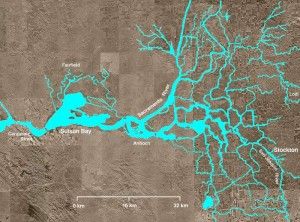Politics clogs solutions to Delta water problems
By Wayne Lusvardi
Members of “Restore the Delta” have recently accused Gov. Jerry Brown of telling a “whopper” that fixing levees in the Sacramento Delta is not feasible.
Brown’s accusers are: Robert Pike and Barbara-Barrigan Parilla. Pike is a consulting engineer and Parilla is director of “Restore the Delta.”
Pike and Parilla say it is a whopper that Delta “levees are in imminent danger of collapse from earthquakes or other events.” They believe that an earthquake is a bogeyman used to justify the building of the proposed Delta tunnels.
By the term “Delta tunnels” is meant twin tunnels that would bring melted snowpack water from the Sierras under and through the Sacramento Delta. The tunnels would be constructed instead of a canal on the ground surface that would go around the Delta (a “Peripheral Canal”). The tunnels would convey water to farmers in the Central Valley and to cities in Southern California.
Pike and Parilla may be right about Delta Plan proponents using an earthquake as an overblown scare story to build the tunnels. But that is not the main reason for proposing what might seem as an absurd notion to convey water in tunnels under the gigantic lake of the Delta. Why would anyone want to transport water under a lake in the first place? Why not just pump water from the other side as they do now?
And who cares if fixing levees is feasible? What does strengthening levees have to do with the dual goals of the Bay Delta Conservation Plan of environmental restoration and the increased reliability of exported water? Or are levees a “red herring” diversion from what should be asked?
Restore Salmon Runs, Not Levees
Fixing the Delta for both water agencies and fish means restoring more of the east-to-west flow of water from the mountains to the sea. This would allow salmon to spawn upstream in fresh water and then migrate back to the saltwater sea. So diverting some water upstream to flow under the Delta would enhance east-west water flow.
Today, water is pumped southward from the south end of the Delta to farms and cities. This interrupts the natural east-west flow just as pulling the plug on a bathtub pulls water toward the drain.
The only way to convey water from North to South, so that it does not interfere with East-West flow, is in a separate conveyance facility: a peripheral canal around the Delta or tunnels under the the Delta..
Under the co-equal goals of the Bay Delta Conservation Plan, it is supposed to split the difference between East-to-West for fish and North-to-South for people.
In fact, water is stored upstream from the Delta by the State Department of Water Resources and the U.S. Bureau of Reclamation so that Delta levees are less threatened by flooding.
Levees are a Diversionary Issue
Strengthening levees has nothing to do with real Delta fish “restoration” per se. Delta restoration would literally mean removing the levees and returning the Delta to an Inland Sea like it was 150 years ago. The pre-levee Delta occasionally suffered from disastrous floods that destroyed both human and wildlife habitats, including fish. The issue of levee feasibility is meant to divert attention from the real ecological restoration issue. What the Delta Plan is all about is the modernization of the Delta so that it works for both fish and people.
What half of the Bay Delta Conservation Plan is about is the restoration of the East-West flow of water so that it doesn’t impede the natural course of fish migration.
So why would Pike and Parilla raise a diversionary issue of levee feasibility that has nothing to do with restoring fish migration routes? The answer seems obvious. They want to shake down farmers and cities to fix Northern California levees as a condition of approving the Bay Delta Plan.
Brown has properly called their bluff. Spending huge sums upgrading all levees that may or may not be damaged in an earthquake is not cost-effective. Anything can be engineered if cost is no consideration. Levees located on land that is prone to liquefaction can probably be engineered to withstand most earthquakes. But the cost would likely be astronomical. It would be more cost-effective to try to engineer locks that would prevent seawater intrusion into the Delta than to try to unrealistically upgrade levees from collapse.
Big Ag Bogeyman
Pike and Parilla float some “bogeymen” of their own: “Big Agribusiness.” This is not too wise a move since Central Valley farmers are needed to pay their share of the Bay Delta Plan costs through higher water rates.
Southern California cities could finance the Delta Plan alone. But that would entail about a $240 per year water rate hike for all their water ratepayers, including households, by this writer’s estimate. And it would mean providing a gift of more reliable water to Delta farmers and water users at the expense of higher water rates on Central Valley farmers and Southern California cities.
Central Valley farmers could not likely pass higher water rates through to the retail buyers of their agricultural products. This is because agriculture is now a globalized business and cheaper foreign imports would put them out of business.
Farmers have indicated they may be willing to absorb their share of the Bay Delta Plan costs. But they would do so only under the condition that they would not be subject to any future environmental lawsuits. This is what is called “regulatory assurance.”
The payoff of any bonds issued to finance the Delta Plan could not be secured unless environmental lawsuits were held in abeyance. Without assurances of no green lawsuits, bond underwriters would have to charge something like 20 percent interest rates to recover money for investors quickly. Or bond underwriters would just have to refuse funding the Delta Plan. This might be the hidden agenda of environmentalists and northern California special interests. But it doesn’t serve the greater public good. Southern California in particular needs a reliable water supply.
Enviros are Blocking a Solution to the Delta Environment
So it is odd. Environmentalists are the ones blockading any environmental restoration of the Delta fish migration routes. And northern Californians are just holding everyone hostage until they can raise the Delta Plan costs so high that it would reduce the chance it would ever be built. This is a problem of the California Environmental Quality Act: it can be used to hold any project hostage and increase mitigation costs — such as levees — so high that the project is not economically feasible.
The enviros are perpetually willing to sacrifice the Delta for fund raising. If they had not fought the Peripheral Canal in 1982, the Delta ecology would be much better off today.
The consequence of a centrally re-plumbed Delta is that only the highest cost alternative — tunnels instead of an outer canal — can be built. The Delta Plan would be much less likely to be able to be financed, with environmentalists driving up the costs.
Markets, on the other hand, are mechanisms to find the least cost. Many natural resource economists say the best way to conserve water is to merely raise its price: to tack surtax on water. But we are witnessing a “blue sky” $50 billion-plus total cost for a new Delta water system that is rendering it economically too costly. Nothing can be built when the costs are limitless.
For example, water agencies have already spent $150 million on environmental studies to tell us what we already know: water has to be allowed to flow to the sea to restore salmon runs.
Despite Brown rejecting levee upgrades as part of the Delta Plan, financing for the project remains a “whopper” fish story anyway.
If the Delta Plan fails, the California water system situation would go back to the stalemates experienced with the Peripheral Canal vote of 1982, the inaction of the Bay-Delta Accords and the Cal-Fed Plan of 1994.
In California, some political Progressives want to move ahead with a newly engineered Delta water interchange. Other Progressives want to use “restoration” slogans to stop the Delta Plan or make its costs prohibitive in order to halt population growth. The California Constitution declares all water in the state to be commonly owned by everyone in the state and that it is supposed to be put to beneficial use.
Granting Southern California state water agencies the power of eminent domain for subsurface tunnels could be one way to simply solve this political logjam. And granting waivers of the environmental impact clearance process in return for the greater ecological benefit upon completion of the Delta Plan might also be considered.
Anything short of complete authorization of the Delta Plan and its accompanying Water Bond, or the alternative proposed above, would regress the implementation of the Delta Plan back to merely telling “whopper” fish stories.
Related Articles
House GOP whip: Folly to expect fed $ for bullet train
April 12, 2013 By Chris Reed There’s a double-whammy targeting the bullet train on the op-ed page of Friday’s U-T
Feinstein/Boxer drought-relief proposal already carried out
On Feb. 11, 25 days after Gov. Jerry Brown declared an official drought, California Sens. Dianne Feinstein and Barbara Boxer
Feinstein, Boxer stymie water, power & wildlife for Lake McClure
May 4, 2013 By Wayne Lusvardi New York Times journalist Peter Passell once wrote: “California’s water system might have been




